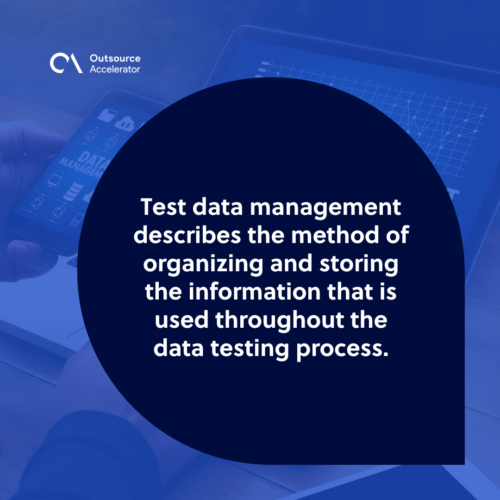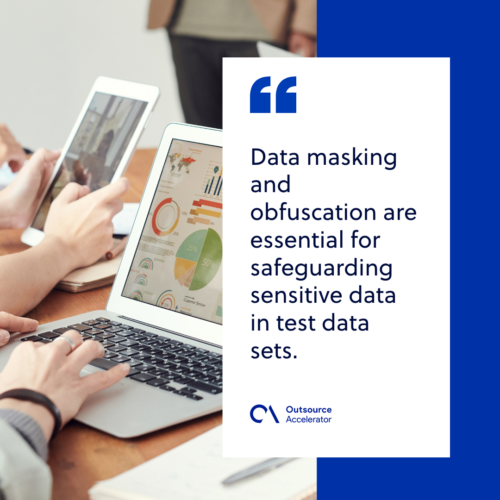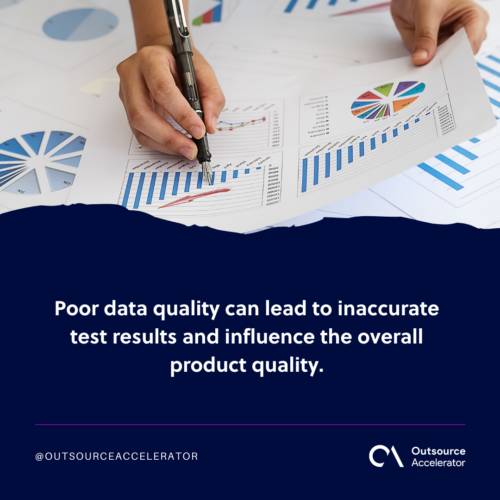7 best practices for streamlining test data management

Developers utilize test data to check and improve program functioning. This may include standard or essential user flow testing and altering any defects in the system.
In the data testing process, application programming interfaces are required to interchange electronic data in real-time seamlessly.
This occurs even when engaging with APIs from many suppliers and partners.
DevOps and quality assurance teams frequently wait for test data from data sources when doing integration and API testing. This often results in delays — which might affect the sprint or the overall delivery of the program.
To avoid application testing delays, you must have instant access to real test data via test data management (TDM).
Test data management allows you to develop and manage safe and permitted datasets that your firm may utilize across many teams. You can also use TDM to validate a software application’s functioning.
This article introduces what test data management is, its challenges, and its seven best practices.
Introducing test data management (TDM)
Test data management describes the method of organizing and storing the information used throughout the test data coverage.
Test data sets’ creation, maintenance, and utilization are all components of the test data management process.

Moreover, these records are used to assess software applications, which must match the events that occur in the real world. This data-driven testing ensures that the creation of any software application is:
- Accurate
- Secure
- Easily accessible whenever required
Test data management must involve the synchronization of multiple data sources to facilitate agile software development and automated testing, starting from the following stages:
- Production
- Versioning of copies
- Finding of sensitive material
- Masking of compliance data
- Distributing test data over several clouds
A test data management system assists the chief security officer (CSO) and chief information security officer (CISO) teams in the administration of security measures:
- Data masking
- Authorization
- Authentication
- Data access control
- Audit logs in downstream environments
A test data management platform assists the chief security officer (CSO) and chief information security officer (CISO) teams in the administration of security measures:
- Data masking
- Authorization
- Authentication
- Data access control
- Audit logs in downstream environments
TDM allows businesses to quickly comply with data privacy and compliance rules when sending test data.
Test data management also decreases the data friction experienced by application development and software testing teams while doing the whole data process.
Challenges in managing test data
Handling test data management processes can be challenging for businesses. Resolving these difficulties is crucial to ensuring the quality of the software development life cycle.
The following are some of the common test data challenges businesses face:
Data privacy and security concerns
Data privacy and security are among the greatest obstacles in the entire testing process. Test data might compromise confidential information, which must be protected from unauthorized access.
Solution:
Organizations must ensure testing data is inaccessible to unauthorized parties to avoid data intrusions and other security risks.
Organizations can protect sensitive data by using data masking and obfuscation techniques. The test data management team must also implement access limitations for non-members and activate history to view who recently accessed these records.
Lack of data availability
Another problem in handling test data is the lack or total absence of required data. Test data must be available when needed, and delays in receiving the information might disrupt the process.
This might cause software development and testing delays, lowering overall product quality.
Solution:
Organizations must use a reliable test data management tool to produce the appropriate data sets needed. They can also employ data versioning and tracking to guarantee that the information used for software testing is always up-to-date and correct.
Data quality issues
Poor data quality can lead to inaccurate test results and influence the overall product quality.
As mentioned, test data management must ensure that the gathered data meets quality testing results. Businesses must also guarantee that testing data is trustworthy and representative of real-world occurrences.
Solution:
Use data profiling and analysis tools to examine test data and identify any issues that must be solved to address data quality concerns.
Organizations can also utilize test data management tools to generate synthetic test data sets that mimic real-world circumstances.
Sensitive data
Managing test data involves handling sensitive information. Protecting records, such as personal information or proprietary business details, is critical to complying with privacy regulations and maintaining user trust.
Solution:
For better test data coverage, implement robust data masking, encryption, and anonymization techniques to ensure that test environments do not inadvertently expose or misuse sensitive data.
Additionally, handling sensitive data necessitates stringent access controls and thorough auditing processes to prevent unauthorized access and data breaches.
Data complexity
Diverse test datasets can be difficult to read and organize.
Real-world occurrences must be reflected in the testing data, which may necessitate the usage of simple data structures to comprehend and file easily.
Solution:
Organizations can employ test data management solutions that can handle complex data structures to overcome difficulties with data complexity.
Firms can also use data profiling and analysis tools to find any problems with the test data sets and ensure they are accurate and indicative of real-world circumstances.
Cost of managing production data
Finding problems with the test data sets entails employing open-source test data management tools, which can be expensive. Companies must ensure they are using the most economical methods of test data management.
Solution:
Businesses can use data masking and obfuscation techniques to lessen the risk of data breaches and other security problems and address the expense of handling test data.
To verify that the test data used for software testing is current and accurate, they may also utilize data versioning and tracking, which can help lower the testing cost.
Test data management: 7 best practices and examples
Some of the abovementioned solutions for the challenges in test data management are further explained as best practices below:
1. Data profiling and analysis
Data profiling and analysis are critical components of test data management that entail evaluating test data to find patterns and trends. This assists companies in understanding the quality of the data and identifying any issues that require attention.
Organizations can use data profiling technologies to find duplicate data, missing data, and data discrepancies.
An organization, for instance, can utilize data profiling technologies to detect patterns in consumer data such as age, gender, and geography.
This can assist businesses in understanding their clients’ demographics and building test data sets typical of real-world circumstances.
Companies can also utilize data profiling to discover missing or inconsistent data, which can help improve the quality of testing data.
As a result, the test data management team can guarantee that the test data used for software testing is high quality.
Further, data profiling and analysis can assist DevOps and software development teams in identifying software issues earlier in the testing process.
2. Data masking and data obfuscation
Data masking and obfuscation are essential for safeguarding sensitive data in test data sets. This assures that the testing data is safe and does not include sensitive information.
An enterprise, for example, can employ data masking techniques to conceal social security numbers, credit card numbers, and other sensitive information.
On the other hand, data obfuscation transforms data into a different form but with the same content to protect it.
This method is useful in financial institutions or retail businesses that accept credit card payments without revealing the actual data to a third-party processor.
As a result, organizations may guarantee that the test data used for software testing is safe and does not contain sensitive information that could be used for harmful reasons.

3. Execute test data provisioning
The process of developing and managing test data sets that are accurate and indicative of real-world circumstances is known as test data provisioning.
This guarantees that the data utilized for testing is of good quality and capable of detecting software flaws.
For instance, a company can utilize test data management tools to generate test data sets that imitate client sales, subscriptions, and returns.
Organizations may guarantee that the test data used for software testing is reliable by applying this best practice in the test management process.
4. Run data versioning and tracking
Changes made to test data sets must be recorded, which is what data versioning and tracking are all about. By doing so, test data management teams know that the information they utilize in their tests is reliable and up-to-date.
For instance, a company can monitor modifications to test data by using version control software. This can aid IT, software development, and DevOps teams in finding and cleansing bugs in the program.
5. Refresh and cleanup
Maintaining correct and up-to-date test data is essential in test data management. This guarantees that the program being tested is being put through realistic scenarios. Outdated test data can result in incorrect testing conclusions, harming product quality.
Cleaning and refreshing test data sets include deleting outdated data and ensuring the data used for testing is current.
By testing the software in its intended environment (the real world), bugs can be found, and the overall quality of the product can be increased if the test data is kept up to date.
In addition, this method guarantees that the test data sets accurately reflect the actual state of the application under critical observation.
6. Test data generation
Generate synthetic test data sets that reflect real-life scenarios. This will guarantee that the test data used for software testing matches the actual behavior of consumers in the real world.
Using test data generation tools, for instance, a company may produce test data sets that replicate various situations, including:
- Client transactions
- Client returns
- Client subscriptions
- Client feedback
7. Invest in the appropriate test data management tools
Businesses must use the right test data management tools to ensure the quality, efficiency, and security of their software development processes.
These tools help create and maintain accurate and relevant test data, which is essential for thorough and effective testing. Proper test data management tools help:
- Streamline data provisioning
- Reduce the risk of errors
- Enhance test coverage
They also facilitate compliance with data privacy regulations by incorporating robust security features, such as data masking and encryption. Using the right tools lets development and testing teams deliver high-quality software faster while maintaining data integrity and security.
By applying this one of the test data management best practices, developers may ensure that the test data used for software testing is precise and realistic.
Overall, test data management is a critical aspect of software testing. Organizations must adopt these best practices to ensure test data is accurate, secure, and available when needed.








 Independent
Independent




